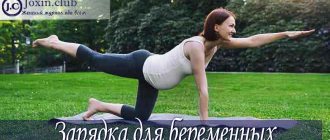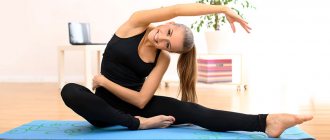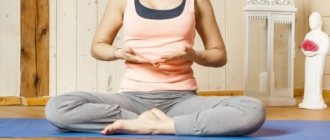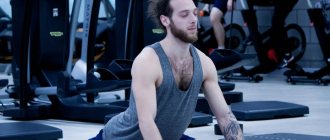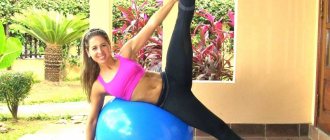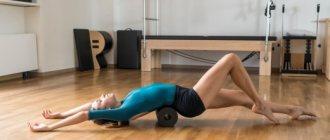Rhythmic gymnastics has a strong appeal not only for little girls who love the gymnasts' pretty, shiny costumes, but also for mothers who want their children to be strong, graceful and successful. After all, rhythmic gymnastics is at the same time acrobatics, dancing and good psychological preparation. But behind the beautiful cover there is a whole invisible world - hard work, disappointments, defeats, injuries. Of course, if you have the opportunity and desire, you should definitely give the girl a lesson. But you need to know all the positive and negative sides that are present in this sport.
Why do you need gymnastics?
The word “gymnastics” comes from the Greek gymnastike, which literally means “I train”, “I exercise”. Gymnastics is understood as a set of physical exercises that promote health, development of muscles and the musculoskeletal system. Most people associate such exercises with morning exercises. But besides this, gymnastics can be practiced professionally, like any sport. Moreover, even small children are taken into this sport.
Don't underestimate gymnastics. They help keep the body in good shape, develop agility, strength, endurance, and promote weight loss.
Daily exercise has a positive effect on the respiratory and cardiovascular systems, so it is often used as a therapeutic, preventive and restorative agent for many diseases.
Morning physical exercise energizes you for the whole day and increases your performance.

Non-professional types of gymnastics are recommended for people of almost any age - from young to old. Thus, in preschool education it is used in physical education and morning exercises: this allows hyperactive children to throw out excess energy, and calmer children to cheer up and tune in for a fun and active day. For older people, performing simple physical exercises makes it possible to maintain joint mobility and avoid limitations in motor ability.
It has been proven that regular gymnastic exercises improve metabolism, have a positive effect on blood circulation and increase immunity.
Therefore, doctors strongly recommend including gymnastics in your lifestyle to everyone who has no contraindications to doing it.
If the child does not want to exercise
It happens that a child wants to go to class, but when faced with difficulties, he begins to be mischievous and say that he does not need this. It is impossible to conduct classes effectively under such conditions. If you need to interest your child, buy the girl a nice training suit. Or let them practice in fancy costumes for performances. Wear a beautiful hairstyle and light children's makeup for class. With such promises - to buy a gymnastic hoop, a wrap for a hoop, clubs and decorate them beautifully - you can persuade a child to practice effectively for a long time.
It is necessary to intensively distract the child from difficulties until the first competition. If the result is positive and the child takes a prize, his eyes will light up and this will be a good incentive to study in the future. If it didn’t work out, you need to focus on the elements and exercises that worked best and praise the child. You also need to pay a little attention to mistakes so that the child can improve his level in subsequent classes.
You might think that a small child does not understand anything, and he can simply be forced to go to gymnastics. But in rhythmic gymnastics, as well as in artistic gymnastics, children grow up very early. Constant stress and discipline quickly make them psychologically older, and a lot of things can be explained to such a child as to an adult. Therefore, explain to your child the benefits of gymnastics (they can be more successful), future prospects (you can get a profession early) and it will be easier for such an athlete to practice.
Varieties
- General developmental gymnastics , as a rule, is used to develop new skills in a person and includes walking, running, working with weights (dumbbells, barbells, etc.), climbing and much more. This type of gymnastics stimulates the functioning of internal organs, accelerates metabolic processes, and strengthens the neuromuscular system. In domestic sports medicine, general developmental gymnastics is considered an excellent means of relaxation after intellectual stress, as well as a way to increase performance.
- Hygienic gymnastics is known to many from basic morning exercises. The exercises are aimed at improving blood and lymph circulation, eliminating stagnant processes, and developing correct posture. Hygienic gymnastics is the prevention of a number of diseases. In addition to general strengthening exercises, this type of gymnastics uses elements of stretching and hardening.

- Athletic gymnastics is aimed at building muscle mass, losing excess weight, developing endurance and strength. The main principle of this type of gymnastics is repeated repetition of exercises with a systematic increase in load. Usually people do athletic gymnastics in gyms and fitness clubs. To make exercises more effective, they should be combined with reasonable cardio.
- Rhythmic gymnastics has a positive effect on the cardiovascular system (running and jumping), the locomotor system (bending and squatting), the nervous system (stretching), increases joint mobility, develops muscle strength and plasticity. All exercises of this type of gymnastics are performed to special music. Depending on the objectives, rhythmic gymnastics can be dance, athletic, recreational, or psychoregulatory.
- Therapeutic gymnastics is one of the main forms of prevention and treatment of various diseases. A set of exercises is developed by a specialist taking into account the specific physical capabilities and diagnosis of the patient. This type of gymnastics does not involve a large load on the organ or organ system, but helps restore their functionality. Moreover, therapeutic exercises have a positive effect on the body as a whole.
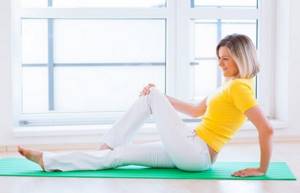
- Rhythmic gymnastics belongs to the category of sports disciplines. It includes exercises with non-supported jumps, with objects (ribbon, ball, hoop, etc.) and without them. In this type of gymnastics, physical exercises, dance elements and musical accompaniment are closely connected. Rhythmic gymnastics develops all muscle groups, coordination, helps to form correct posture, and increases flexibility. Professional athletes who have been involved in artistic gymnastics for many years master dozens of acrobatic exercises.
- Artistic gymnastics involves performing exercises on various gymnastic apparatus (rings, pommel horse, uneven bars, beam and others). In addition, floor exercises on a flat surface are a mandatory element.

Schedule and school performance
There is often an opinion that gymnasts do not have the opportunity to fully study at school and attend other sections. This is partly true, because at an early age children engage in rhythmic gymnastics for up to three hours a day, three to four times a week. And very soon, in the second or third year, the load increases to three to four hours a day, and classes are held daily.
But you need to take into account that a child, having a busy schedule, becomes more disciplined, and labor productivity increases significantly. If a girl is responsible, even when she comes home at eight in the evening, she will quickly have dinner and in an hour and a half will be able to do as much homework as an ordinary schoolchild does in three to four hours. After all, if there are no additional classes, the child sits for a long time at the computer or walks aimlessly in the yard, and homework turns into rushing between food, games and sitting on social networks.
So performance at school depends entirely on the efforts of parents to try to help with homework, namely, to explain to the child points that he does not understand well, for example, in mathematics or a foreign language. After all, there are successful gymnasts who attend sports school every day and at the same time are excellent students in regular schools.
The situation is similar with the music school. There is an opinion that it is impossible to combine sports and music school (in addition to the usual general education). But this is absolutely not true. The fact is that classes at a music school consist of four hours a week - two hours for practical lessons, one hour for solfeggio, one hour for musical literature, and you don’t have to take part in the choir - this is optional. Artistic gymnastics, when attended daily, takes at least 20 hours a week, in reality more for successful athletes (who can do more in preparation for competitions), so if you agree with a coach and choose a music school closer to you, you can quite successfully receive a music education as well . Moreover, the time of practical classes can be adjusted, and it is not necessary to attend musical literature and solfeggio every time.
Such irregular classes at a music school can negatively affect a girl’s musical success, but have a positive impact on her sports success. After all, such a switch to another type of activity disciplines the child even more and also gives the body a psychological break from constant physical activity. The main problem in visiting another section is the will of the sports coach, who is usually very jealous of his sport and is categorically against attending another type of class, a music school in our case. And no arguments that this is for general development, useful for the girl and that it will not harm the sport, do not work.
Sometimes all that remains is to adjust the classes so that the sports school does not notice the classes at the music school, having come up with, for example, that the child at such a time goes to English, for example, the trainers are more loyal and less jealous of the language courses. Moreover, it needs to be adjusted so that additional classes take place before training, since no one will be allowed to leave training, at least on a regular basis.
Where to start classes?
Modern people often do not have enough time to go to the gym, so a large number of people stop at home exercises. In order for gymnastics for beginners to be fruitful and become a habit, you need to remember a few recommendations:
- You need to develop the habit of waking up 15 minutes earlier than usual. This is necessary so that the lesson has a normal pace, because no one wants to reduce the usual time allotted for hygiene, eating and cosmetic procedures.
- As soon as a person wakes up from sleep, he should not jump out of bed. First you need to do a couple of breathing exercises and self-massage. All this will help you recover faster after sleep and cheer up.
- You need to choose exercises that will correspond to the degree of training and the general condition of the body. Perhaps a person suffers from some kind of disease, in this case, before starting classes, you need to consult with your doctor.
- The number of repetitions of exercises should be selected individually. The same applies to the rhythm of movements.
- The load should be increased gradually. If discomfort or shortness of breath appears, you need to stop doing the exercise or reduce the load.
- Gymnastics for beginners must include exercises in which the load is evenly distributed to all parts of the body so that all muscle groups are involved.
- When doing gymnastics, you need to monitor your breathing. It should be uniform and deep. This will allow the muscles to be fully saturated with oxygen.
- It is best to exercise in special comfortable clothing that does not restrict movement. It is better if the training suit is made of cotton fabric.
- If possible, it is preferable to do gymnastics in the fresh air. As a last resort, you can open the window.
- It is best to do gymnastics while listening to fast and rhythmic music. This will allow you to tune in to a positive mood.
- After training, it is recommended to take a shower.
- During the day, you should try to do at least a few exercises that will help relieve stress.
- Walking is a must every day. In this case, you should perform special breathing exercises.
- If a person has already started doing gymnastics for beginners, then one should not stop training under any circumstances. The only exception is a very high temperature or a serious illness.
At what age can you start training?
Rhythmic gymnastics can be practiced regularly from the age of four. Until this age (at three years), you can bring your child to the gym once a week to interest him and so that he gets used to the environment. From the age of four, a child is taken to gymnastics informally, two to three times a week. Moreover, during the first classes, the presence of parents is mandatory (not in the gym, but near the sports school) in order to, if possible, smooth out the psychological discomfort that the child may have.
But, however, at the age of four there are girls who are well physically prepared and psychologically prepared for classes no worse than older children. Of course, such children are an exception, but it is precisely such gifted children that coaches are looking for. The sooner you start practicing, the better, because such children stretch well into splits, do folds, and in general, difficulties will be easier to bear if they become somewhat of a habit. However, if the child is interested, there will be no problems with the classes. Officially, sports schools recruit girls at the age of 4-5; such preschool children can already take responsibility for future results.
Simple exercises for weight loss
It is common knowledge that in order to get rid of extra pounds you need to burn more calories than you consume. Many people suffering from excess weight try to solve this problem with all kinds of diets. But without gymnastics it is almost impossible to cope with excess weight. To achieve results and a slim body, you need to make a lot of effort, you need to exercise hard and, sometimes even through “I can’t and don’t want.” Only then the gymnastics performed will force the muscles to work in such a way as to burn the hated calories. Example exercises could be as follows:
- The “Scissors” exercise is a very good way to work out your abs and get rid of folds on your stomach. To perform this exercise correctly, you need to lie on the floor and rest your hands on it, then slowly raise your legs at an angle of 90 degrees, alternately crossing them with each other. In the same way, your legs should be lowered to the floor. For the best results when doing gymnastics for beginners, it is recommended to do 2-3 sets of this exercise 10 times.
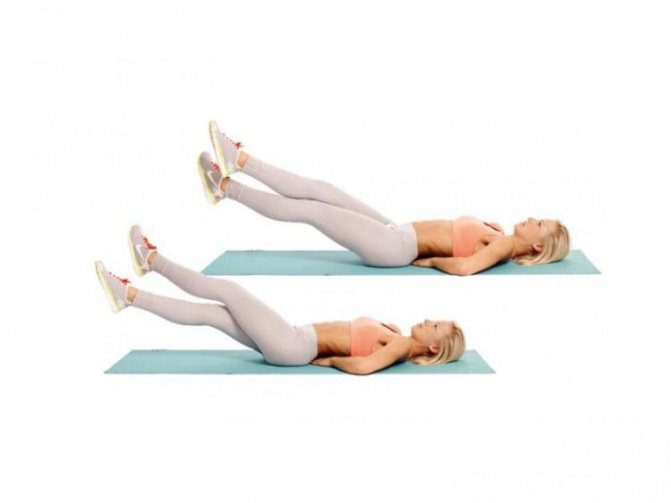
- The “Book” exercise is also intended for the abs and includes all abdominal muscles in the workout. To perform this exercise, you need to sit on the floor, rest your hands on your back and tilt your head back a little. And then you should move on to pulling the bent legs and body towards each other. This is reminiscent of book addition.

- Lunges in one place can also be considered the most effective exercises, leading to maximum energy expenditure. You need to lunge forward as wide as possible with your left leg, while your right leg should remain motionless. In this position, you need to squat deeply, bending the “dropped out” leg at the knee. For each leg you need to do at least 2 sets of 10 times. You can make this exercise more difficult by using dumbbells.
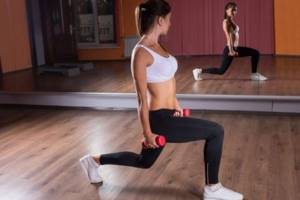
- Jump from a sitting position. You need to place your feet shoulder-width apart and squat down. This will be the starting position for the exercise. From this position, a sharp jump is made, arms need to be extended in the same direction. Then a return is made to the starting position and again a jump from it. You can't stop and pause.

- Reverse grip push-up. To do this, you need to sit on the edge of, for example, a sofa and lean your hands on it from behind, stretch your legs in front of you. And from this position do push-ups, sagging down. When performing this exercise, you need to ensure that your back and pelvis are on the same line and do not bend down.

The exercises listed above are ideal for beginners who have just started doing gymnastics for the purpose of losing weight. If you repeat this set of exercises daily or at least every other day, the results will become noticeable within a few weeks. But only if you follow proper nutrition.
Underwater rocks
Rhythmic gymnastics will have a coach. No wonder, every sport will have a coach. But if the mentor spends up to 30 hours a week with the child, then a lot depends on him. Building a relationship with a coach is quite easy, but there are circumstances when you may be unhappy with him - for example, in a group he will give preference to someone else. In gymnastics, the children of the coach’s acquaintances, the children of other coaches and the children of important (and rich) people practice, they will be in first place. You may be unhappy with the situation, but you must understand that if your child is not a “protégé”, then you can only come to the fore with triple the work, there are no other ways. The situation is similar with judging; it is not always objective, but having a serious advantage in an impeccably executed complex program, subjectivity can be overcome and a decent mark can be obtained.
There is no point in arguing with the coach - it will only harm the child, who spends dozens of hours a week with the student and can always get even, for example, by scolding him for exercises. After a damaged relationship, moving to another coach will be a difficult task, since a student in gymnastics is considered almost the property of the coach and the only way to leave him is to leave the sports school. And even if there is an opportunity to go to another coach at the same school, the teaching staff may be very friendly, and the training options will be the same or even worse.
One more point - rhythmic gymnastics, even for beginners, will require costs. Costumes, accessories, trips will cost money. But keep in mind that gymnastics is very difficult work. Not every adult works as hard throughout the day as young gymnasts work for several hours, constantly performing exercises. Therefore, your child does not need to skimp on extra beautiful accessories - let it be his salary. There is another side of the coin - a child who suffers in gymnastics begins to feel sorry for him at home. Thus, a hard worker in rhythmic gymnastics, even if he is a super-champion, becomes a slacker. If nothing is done, the problem may be noticed too late. There just aren’t enough classes in general education and sports schools for education, so let’s do homework - cleaning, washing dishes, at least a little, you can also plant a special garden for labor education.
Rhythmic gymnastics, due to its numerous complex exercises, leads to numerous injuries and chronic diseases. Therefore, if a child has pain in his joints, knees, ankles and a break in exercises did not give any improvement, consider switching to another sport, perhaps sports dancing, where gymnastic training will be useful, but there will not be such a load.
Qigong gymnastics

The most ancient health-improving gymnastics is considered to be qigong gymnastics. It is aimed at restoring human health and giving him the opportunity to achieve longevity and well-being. The technique of such gymnastics is to use methods of healing the body, which were collected and passed on by the wisest people from China to their descendants more than seven thousand years ago. It is based on a combination of breathing and healing exercises.
Chinese philosophy imagines that the whole world is filled with Qi energy. This energy is omnipresent. It is present in the air, plants, buildings, and in the human body.
The main task of qigong gymnastics is to give a person the opportunity to normalize the flow of Qi in his body and increase its circulation. This gymnastics is done to a slow and harmonious musical composition and helps to harmonize a person’s physical, emotional and intellectual state. The exercises used in qigong gymnastics help slow down the aging process of the human body. According to qigong masters, most people breathe completely incorrectly and use a small part of their lung capacity. Qigong gymnastics allows you to expand the capabilities of the respiratory system, ensure continuous exchange of oxygen and carbon dioxide, improve blood circulation, and also helps maintain good physical shape.
Principles of Tibetan exercises
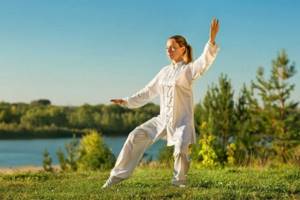
The peculiarity of Tibetan gymnastics can be expressed in three postulates:
- Regularity of training.
- Correct breathing.
- A strictly defined number of repetitions of exercises.
If a person violates at least one condition, then there will be no effect from Tibetan gymnastics. Also, if a person has a goal not only to improve his health, but also to lose weight, then he needs to adhere to proper nutrition. The basis of such nutrition should be cereals, fruits and vegetables.
If you properly organize the process of gymnastics and adjust your lifestyle and nutrition, the result will not take long to arrive.
Eastern gymnastics
Eastern morning exercises consist of simple exercises that include movements, pressure, and rubbing important parts of our body. It is very effective, gives a person energy and strength, according to Eastern sages, it opens and activates energy channels and centers, or chakras. The history of eastern gymnastics is very ancient, it is called differently: gymnastics of Tibetan lamas or hormonal, ancient Tibetan self-massage. Also, these exercises have a special, close connection with classical yoga exercises.
Look at the pictures of how and where the chakras are located on the human body. When you read and analyze all the gymnastics exercises, you will immediately be convinced of the connection and stimulation of the human body. Giving our body energy, good health, and mood for the whole day is now very important, and daily oriental morning exercises will help with this.
Gymnastics takes 6-8 minutes, performed after waking up in bed, or on the floor using a mat.
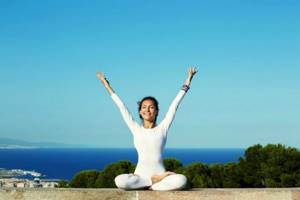
Exercise 1 : when you wake up, you need to lie down for 2-3 minutes with your eyes closed, then rub your hands so that they become hot. Massage your ears: take a handful of your index, thumb and middle fingers and rub your ear from top to bottom. Do it 25-30 times, with your thumb behind your ear.
Eastern alternative medicine believes that there are 11 “lunar” points on the earlobe, responsible for the vital functions of the 11 most important human organs, as well as 120 different points that maintain reflex communication with all organs and parts of the body. Modern medicine does not agree with this opinion, but confirms that there are several large clusters of nerve endings on the earlobe, therefore it has high sensitivity and the ability to extremely actively transmit signals to the brain, primarily in the spinal cord. The importance of the first exercise is obvious.
Exercise 2 : place your right palm on your forehead, on the line of your eyebrows, cover it with your left palm, focus on the third eye point (between the eyebrows) and move your forehead skin left and right with your palm, do 25-30 times. The Ajna chakra is stimulated.
Exercise 3 : clench your hand into a fist, use your thumb knuckles to massage your closed eyes 10 times - from the nose to the ears. Vision and blood supply to the brain improves.
Exercise 4 : place your right palm on the thyroid gland , your left palm on top and move your hands, pressing lightly, from top to bottom - from the throat to the solar plexus, do 25-30 times. Three chakras are stimulated at once - Vishuddha, Anahata, Manipura.
Exercise 5 : lie flat, exhale, pull your stomach in as far as possible, then inhale and push it forward as much as possible. Do up to 30 movements, average pace. The yoga system includes exercises with similar breathing. The Manipura and Svadhisthana chakras are stimulated.
Exercise 6 : lying on your back, exhale and pull your right knee up to 15 times, then the left knee the same amount, at an average pace.

Exercise 7 : put your right hand on the solar plexus , your left hand on top, make circles around the stomach with clockwise pressure 25-30 times. Do not press on the navel area, make large circles. The Manipura and Svadhishthara chakras are stimulated.
Exercise 8 : Raise your arms and legs up, palms and feet parallel to the floor. First, we rotate our arms at the wrists, and our legs at the ankle joints, then we shake for 30-40 seconds.
Another version of this exercise: legs straight, hands on the back of the head, inhale - raise your legs behind your head, exhale - lower them, do 8-10 times. If it is difficult to perform with straight legs, bend your knees slightly. Experiment and choose the option that suits you, you can also do both.
Exercise 9 the indentation with your knuckles 30 times. Then do the same with your right leg.
The importance of this exercise is enormous: the notch is located in the middle part of the ball of the foot, when walking this area is in direct contact with the floor. It provides elasticity to this part of the body due to the tendons and joints, and when they weaken, the notch lowers. When the notch is deformed, a person may experience an abnormal gait, and then there may be a negative impact on the joints of the knees, buttocks, sacrum, pelvic area, and possibly on the spine.
Exercise 10 : sitting, place your right palm on the back of your head, your left hand on top and move your hands, pressing lightly, left and right 15 times, then down and up to the top of your head 15 times. This last exercise massages the back of the head well; if you have high blood pressure, do it carefully and listen to the body’s reaction. The Sahasrara chakra is stimulated.
Chinese tai chi gymnastics for beginners
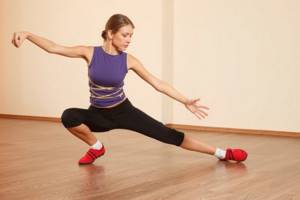
Chinese Tai Chi gymnastics for beginners will help you learn correct and smooth movements. You can do it on any non-slip surface in rubberized shoes or socks, or on the street - barefoot. Light clothing that does not restrict movement is suitable.
Beginners study in groups of 10 people under the supervision of a master, performing Chinese lessons:
- Waterfall of freshness - standing straight, bend your knees, extend your arms, lean your head slightly forward. Slowly tilt your shoulders forward and stretch your body. Make sure that the muscles are not tense. Go back smoothly.
- Water circles – place one hand on your waist, the other on your abs. Smoothly turn your pelvis clockwise, twist it to the sides.
